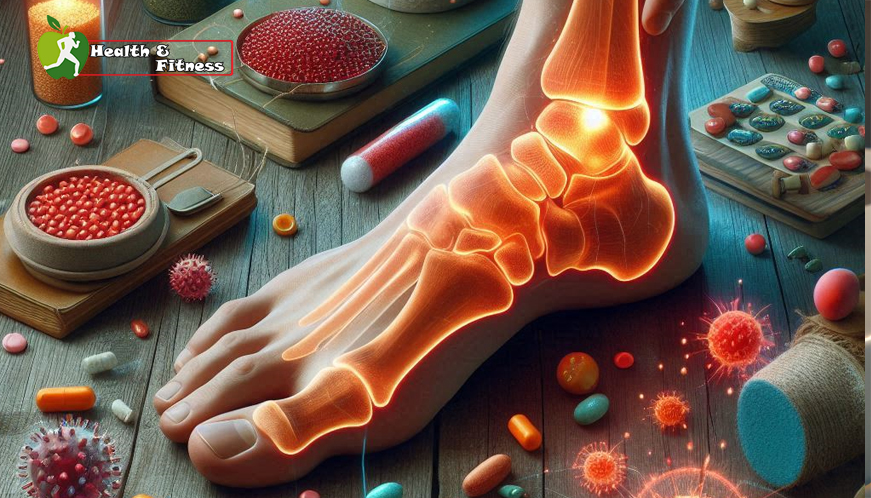Is ankle or heel pain making it hard to walk? Gout could be the reason. It’s a painful kind of arthritis. It happens when uric acid crystals form in your joints. It often hits the ankle and heel. Let’s talk about what causes gout. We will also discuss how to handle it. Plus, we’ll look at how to live without the pain.
Understanding Gout: The Root Cause of Ankle and Heel Pain
Gout isn’t just another ache. It has a clear cause. It is different from other joint problems. Understanding this can help you get the right care.
What is Gout? Definition and Pathophysiology
Gout is a condition from too much uric acid in your body. This is called hyperuricemia. Uric acid can make crystals in your joints. These crystals cause swelling and intense pain. This is often in the foot.
Gout vs. Other Forms of Arthritis
Many types of arthritis exist. Osteoarthritis involves the wearing down of cartilage. Rheumatoid arthritis is an autoimmune disease. Gout stands apart because of those uric acid crystals. Each type needs its own treatment.

Recognizing the Symptoms: Identifying Gout in Your Feet
Knowing gout’s signs is key. Catching it early can prevent long-term issues. Look for these clues in your feet.
Common Signs and Symptoms of Gout in the Ankle and Heel
Gout can cause sudden, sharp pain. You might feel it intensely in your ankle or heel. The area may swell, turn red, and feel warm. Even a light touch can hurt. These flare-ups can last for days or weeks.
When to Seek Medical Attention
Don’t wait if you suspect gout. See a doctor if you have bad pain or a fever. Limited movement is another warning sign. Early help can stop problems down the road.
Risk Factors and Causes: What Increases Your Chances of Developing Gout?
Some things make you more prone to gout. Knowing these risks can help you take action. Let’s explore the factors.
Lifestyle Factors: Diet, Weight, and Alcohol Consumption
What you eat matters. A diet high in purines raises uric acid. These are found in red meat and seafood. Being overweight also adds to the risk. Too much alcohol can do it, too.
Genetic Predisposition and Other Medical Conditions
Genes play a role in gout. If family members have had it, you’re more at risk. Kidney disease and diabetes can also increase your risk. High blood pressure is another factor.
Medications That Can Trigger Gout
Some medicines can cause gout. Diuretics, for instance, can raise uric acid. Low-dose aspirin can also be a trigger. Talk to your doctor about your medications.
Effective Management Strategies: Relieving Gout Pain and Preventing Flare-Ups
Managing gout involves different steps. You can ease pain and stop future attacks. It requires some planning.
Medications for Gout: Pain Relief and Uric Acid Reduction
Medicines like NSAIDs can lower swelling. Colchicine helps during attacks. Allopurinol lowers uric acid levels. Febuxostat is another option. Know the side effects of each medicine.
Lifestyle Modifications: Dietary Changes and Weight Management
Change your diet to lower uric acid. Eat less purine-rich food. Drink plenty of fluids. Add anti-inflammatory foods. Keep a healthy weight with exercise and a balanced diet.
Home Remedies and Natural Approaches for Gout Relief
Try ice packs to reduce pain. Elevate your foot. Cherry juice may help. These are natural ways to ease symptoms.
Foot Care and Prevention: Protecting Your Feet from Gout
Taking care of your feet is key. This can stop gout issues. It will keep you moving comfortably.
Proper Footwear and Orthotics
Wear comfy shoes. Make sure they have room for your toes. Orthotics can give extra support. They reduce stress on your joints.
Regular Exercise and Joint Mobility
Do gentle exercises to keep joints flexible. Stretching can help. Avoid high-impact moves that can hurt your foot.
Importance of Hydration and Foot Hygiene
Drink enough water to flush out uric acid. Wash and dry your feet to prevent infections. Clean feet are happy feet.
Conclusion
Gout can be managed. Early action is key. Medicines, lifestyle changes, and foot care are important. Don’t let foot pain stop you. For expert care, call our Los Angeles podiatrist at 323-990-0784. Start your journey to pain-free living today!



4 Comments
8nqpq4
lwzizw
2uc2ps
Can you be more specific about the content of your article? After reading it, I still have some doubts. Hope you can help me.